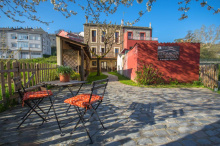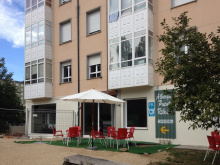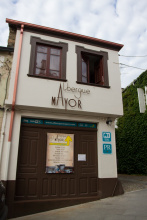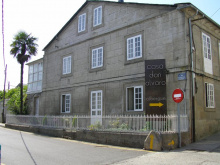Sarria
Camino Frances
Sarria now holds the record for the most albergues in one town. Don’t be alarmed by the swell of pilgrims that appear overnight once you reach this point; the closest city to the minimum 100km point set by the church to be eligible to receive the Compostela Certificate. The effect can be dramatic during the high season and if you have been on the road for a few weeks it can be a challenge to adapt to the change.
If you have arrived early and plan to stay the night, consider the local pool as a place to pamper your feet a bit.
There are plenty of bars and restaurants along the Rúa Maior, where the bulk of the albergues are centered. To get to the grocery shopping though, you have to make your way to the main road where options abound.
The Rúa Maior evolved as a market street during the Middle Ages, due primarily to the pilgrim traffic; and this hasn’t changed. As you walk through town take a moment to admire the well-preserved coats of arms on several of the houses that line the street.
The Iglesia de Santa Maria is an unspectacular example of modern church building, but it does sit atop its 12th century predecessor. The Iglesia de San Salvador is recently restored and is located at the top of the Rúa Maior. Beyond it are the Convento de la Magdalena and the remains of the old Castle. The convent has roots in the 12th century and currently operates as a hospice and a primary school. The Castle is more recent, from the 15th century, and like most castles in Galicia, it is in poor shape. Only one tower remains, the rest was destroyed during the Irmandiña uprisings of 1467 (see below). It was rebuilt, but those efforts also fell into ruin. The remnants have been re-used to pave several of Sarria’s sidewalks.
Along the way between Sarria and Portomarin it is common to find beggars and buskers and the occasional scam artist soliciting your support and money and signature. Do your best to avoid becoming ensnared, the best method is to keep on walking. Also, you are advised to get your credential stamped at least twice a day between here and Santiago.
Archeological digs in the area around Sarria have revealed the presence of a considerable pre-Roman settlement. Documentation supporting more recent inhabitations, on the other hand, is hard to come by, and the earliest written records don’t appear until the 6th century.
Whatever existed at that time was destroyed by the Muslim invasion, and the area wasn’t repopulated until around 750. The town was favored by later Kings and it received funding for several building works from Alfonso IX of León. He was its biggest supporter and he died here in 1230 and is buried in the Cathedral in Santiago.
Irmandiña Uprisings: Also known as “The Great Brotherhood War,” The Irmandiño revolts took place in 15th century Galicia against attempts by the regional nobility to maintain their rights over the peasantry and the bourgeoisie (and by a string of bad crops).
The revolts were also part of the larger phenomenon of popular revolts in late medieval Europe caused by the general economic and demographic crises in Europe during the fourteenth and fifteenth centuries. In Galicia it meant the destruction of any type of fortified structure owned by nobility; over 130 castles were destroyed. The success of the Irmandiña revolts was mixed; the nobility fled to Castile where they rounded up reinforcements and returned to exact revenge on the leaders of the Brotherhood, but few of their former estates and strongholds were ever rebuilt.
The camino exits town along the Rúa Maior in the old town and passes the Convento de la Magdalena. Take note that the camino actually turns left BEFORE arriving at the convent. It goes steeply downhill to the road, turns right, and soon crosses the río Celeiro on the Ponte Áspera. It follows along the river, and in the shadow of a super bridge before crossing the train tracks. The first climb of the day (excluding the stairs in Sarria) is ahead and passes through an ancient forest full of gnarly oaks and chestnut trees.
Accommodation in Sarria.
| Albergue de Peregrinos de Sarria 10€ 40 |

|
| Albergue Credencial 12€ 28 Booking.com |

|
| Albergue Barullo 12€ 20 Booking.com |

|
| Hostel Andaina 14€ 26 Booking.com |

|
| Albergue La Casona de Sarria Booking.com |

|
| Albergue Oasis 14€ 27 Booking.com |

|
| PENSIÓN ALBERGUE MATIAS LOCANDA 10€ 40 Booking.com |

|
| Albergue Puente Ribeira 12€ 30 Booking.com |

|
| Albergue Obradoiro 12€ 38 Booking.com |

|
| Alma do Camiño 13€ 100 Booking.com |

|
| Albergue Mayor 13€ 16 Booking.com |

|
| Albergue A Pedra 14€ 23 Booking.com |

|
| Albergue Don Álvaro 15€ 30 Booking.com |

|
| Albergue Los Blasones 11€ 42 Booking.com |

|
| Albergue O Durmiñento 10€ 41 Booking.com |

|
| Albergue Internacional Sarria 12€ 38 |

|
| Albergue San Lázaro 12€ 27 Booking.com |

|
| Albergue Casa Peltre 12€ 22 Booking.com |

|
| Albergue Monasterio de la Magdalena 12€ 110 Booking.com |

|








Comments